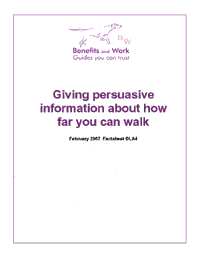
27 February 2007
Benefits and Work has published a 12 page factsheet full of information for claimants who wish to provide detailed evidence about how far they can walk in relation to a claim for higher rate mobility. The factsheet quotes extensively from Atos Origin Medical Service training guides for doctors carrying out medical visits.
Why give detailed evidence?
It's absolutely fine to fill in the page in your claim pack relating to Walking Outdoors just using the information in our guides to claiming DLA and that's what the vast majority of our members do. However, if you're challenging a decision that you're not entitled to higher rate mobility then you may need to give more detailed evidence to rebut what the decision maker has claimed.
Alternatively, you may just want to give as much information as possible in your initial claim in order to try to increase the chances of it being successful without the need to attend an appeal hearing,
It's also worth being aware that Examining Medical Practitioners (EMPs) are more likely to be sent out to investigate whether a claimant qualifies for higher rate mobility on the grounds of virtual inability to walk than for any other reason. But it costs a lot of money to send out EMPs and the DWP are working to reduce the number of such visits that take place. The more detailed evidence you provide, particularly if it's supported by medical evidence, the better your chances may be of avoiding a doctor's visit but still getting an award of higher rate mobility.
What's in the factsheet
The factsheet is divided into two sections. The first looks at what evidence Examining Medical Practitioners are trained to provide in relation to being virtually unable to walk.
The second part looks at what evidence you might wish to provide. It covers giving evidence about issues such as:
the speed that you walk - including challenging the DWP's method of calculating walking speed;
the way that you walk;
what happens when you walk;
information about your typical day;
moving around the house;
medical information
medication and treatment
issues to consider when giving evidence about falls:
increased risk factors and falls;
the importance of cross-referencing.
Members can download a copy of Giving persuasive information about how far you can walk.


